The Nuclear Power Group
With Radbroke Hall being left mainly unoccupied during the 1920s and 1930s, it was sold by the Hardy Family in 1956 to the Nuclear Power Group who built offices and a testing tower on the grounds.

Radbroke Hall is a white French chateau-style former country house in Peover Superior, Cheshire, England. It takes its name from the Red Brook stream that runs through the grounds. [1]
Radbroke Hall was built between 1914 and 1917 for Manchester businessman Claude Hardy and his wife Olga. The architect was Percy Worthington. [2] Originally from Belfast, Claude Hardy had a successful textile manufacturing business in Manchester. Unfortunately, Claude's death in 1916 left his widow to oversee the completion of the building work alone. [1]
The hall is built of Portland stone which was brought by train to a local railway station from Weymouth. Main features of the hall include a white marble staircase, a music room, and an oval dining room. [1] Around the hall were some twenty acres of grounds including attractive rose gardens and areas given over to a large variety of Rhododendrons. The main hall driveway is flanked by large old beech trees.[ citation needed ]
The house and parts of the gardens are recorded in the National Heritage List for England as designated Grade II listed buildings. [3] [4]
With Radbroke Hall being left mainly unoccupied during the 1920s and 1930s, it was sold by the Hardy Family in 1956 to the Nuclear Power Group who built offices and a testing tower on the grounds.

The site was purchased by Barclays from The Nuclear Power Group in 1972. Approximately 1,400 staff were relocated from London to the new site. Today the site is home to the Barclays Technology Centre and mainly focuses on supporting the bank's IT infrastructure. [5]

Lyme Park is a large estate south of Disley, Cheshire, England, managed by the National Trust and consisting of a mansion house surrounded by formal gardens and a deer park in the Peak District National Park. The house is the largest in Cheshire, and is recorded in the National Heritage List for England as a designated Grade I listed building.
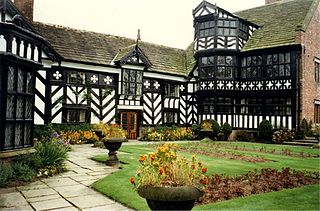
Gawsworth Old Hall is a Grade I listed country house in the village of Gawsworth, Cheshire, England. It is a timber-framed house in the Cheshire black-and-white style. The present house was built between 1480 and 1600, replacing an earlier Norman house. It was probably built as a courtyard house enclosing a quadrangle, but much of it has been demolished, leaving the house with a U-shaped plan. The present hall was owned originally by the Fitton family, and later by the Gerards, and then the Stanhopes. Since the 1930s it has been in the possession of the Richards family. Raymond Richards collected a number of items from other historic buildings and incorporated them into the hall.

Dunham Massey is a civil parish in the Metropolitan Borough of Trafford, Greater Manchester, England. The parish includes the villages of Sinderland Green, Dunham Woodhouses and Dunham Town, along with Dunham Massey Hall and Park, formerly the home of the last Earl of Stamford and owned by the National Trust since 1976. Dunham Massey is in the historic county of Cheshire, but since 1974 has been part of Trafford Metropolitan Borough; the nearest town is Altrincham. At the 2001 census, the parish had a population of 475.
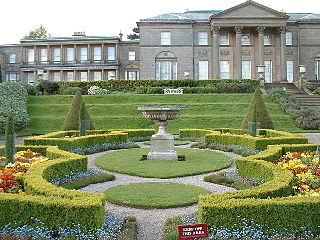
Tatton Park is a historic estate in Cheshire, England, north of the town of Knutsford. It contains a mansion, Tatton Hall; a medieval manor house, Tatton Old Hall; Tatton Park Gardens, a farm and a deer park of 2,000 acres (8.1 km2). It is a popular visitor attraction and hosts over a hundred events annually. The estate is owned by the National Trust and is managed under lease by Cheshire East Council. Since 1999, it has hosted North West England's annual Royal Horticultural Society flower show.
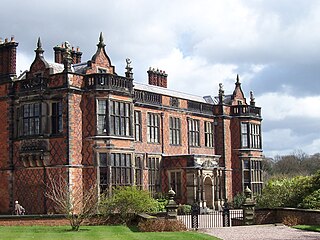
Arley Hall is a country house in the village of Arley, Cheshire, England, about 4 miles (6 km) south of Lymm and 5 miles (8 km) north of Northwich. It is home to the owner, Viscount Ashbrook, and his family. The house is a Grade II* listed building, as is its adjacent chapel. Formal gardens to the southwest of the hall are also listed as Grade II* on the National Register of Historic Parks and Gardens. In the grounds are more listed buildings, a cruck barn being listed as Grade I, and the other buildings as Grade II.
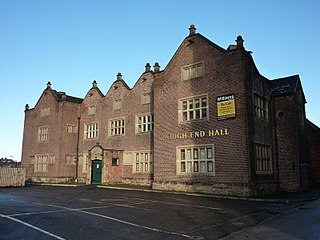
Hough End Hall is a historic house now in Chorlton-cum-Hardy, Manchester, North West England. It was built in 1596 during the reign of Queen Elizabeth I by Sir Nicholas Mosley, when he became Lord of the Manor of Manchester and of the dependent Manor of Withington. The Mosleys were an influential Mancunian family from the 16th century onwards, and prominent in the affairs of the Manchester district for two and a half centuries.

St Oswald's Church is in the village of Lower Peover, Cheshire, England. It is recorded in the National Heritage List for England as a designated Grade I listed building. It is an active Anglican parish church in the diocese of Chester, the archdeaconry of Macclesfield and the deanery of Knutsford. Its benefice is combined with that of St Lawrence, Over Peover.

St Lawrence's Church, Over Peover is in the civil parish of Peover Superior. Close to Peover Hall and farm. It lies some 3 miles (5 km) south of the town of Knutsford. The church is recorded in the National Heritage List for England as a designated Grade I listed building. The church is an active Anglican parish church in the diocese of Chester, the archdeaconry of Macclesfield and the deanery of Knutsford. Its benefice is combined with that of St Oswald, Lower or Nether Peover. It is noted for its old chapels and for the monuments to the Mainwaring family.
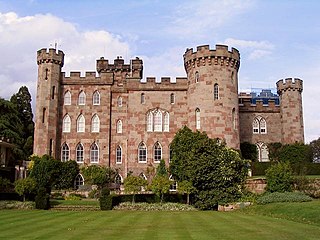
Cholmondeley Castle is a country house in the civil parish of Cholmondeley, Cheshire, England. Together with its adjacent formal gardens, it is surrounded by parkland. The site of the house has been a seat of the Cholmondeley family since the 12th century. The present house replaced a timber-framed hall nearby. It was built at the start of the 19th century for George Cholmondeley, 1st Marquess of Cholmondeley, who designed most of it himself in the form of a crenellated castle. After the death of the Marquess, the house was extended to designs by Robert Smirke to produce the building in its present form. The house is designated by English Heritage as a Grade II* listed building.
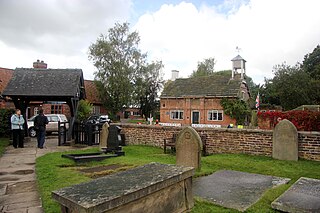
Peover Inferior is a civil parish in the Borough of Cheshire East and the ceremonial county of Cheshire, England. The village is known for its picturesque surrounding countryside and surprisingly convenient location. The name Peover is pronounced 'Peever' and derives from the Anglo-Saxon 'Peeffer' meaning 'a bright river', this 'bright river' being the River Peover which runs through the parish. The village and its neighbour Peover Superior lie on the river Peover, 'Inferior' here meaning downstream. The parish is situated on the B5081 roughly 25 km south south west of Manchester between Knutsford and Holmes Chapel and within five miles of junction 19 on the M6. Together with Nether Peover, it forms part of the village of Lower Peover, Lower Peover being the parish council. Peover Inferior is in Cheshire East, however Nether Peover is in Cheshire West, this often causes complications for the Lower Peover parish council. According to the 2011 census, it had a population of 220.

Peover Superior is a former civil parish, now in the parish of Peover Superior and Snelson, in the unitary authority area of Cheshire East and the ceremonial county of Cheshire, England. It is described by the Office for National Statistics as a village surrounded by inhabited countryside. The civil parish included the village of Over Peover and the hamlet of Peover Heath. In 2011 the parish had a population of 666.
Peover Hall Stable Block is in the grounds of Peover Hall, Cheshire, England. It is recorded in the National Heritage List for England as a designated Grade I listed building.

Peover Hall is a country house in the civil parish of Peover Superior, commonly known as Over Peover, Cheshire, England. It is recorded in the National Heritage List for England as a designated Grade II* listed building.

Colshaw Hall is a large house in Peover Superior, Cheshire, England. It is recorded in the National Heritage List for England as a designated Grade II listed building. The house was built in 1903 and designed by the Chester architects Douglas and Minshull. It is constructed in red brick with stone dressings and a stone roof. It has two storeys plus an attic. Its architectural style is Tudor Revival. It was extended and altered by Percy Worthington in 1907.
Lymm Hall is a moated country house in the village suburb of Lymm in Warrington, Cheshire, England. It is recorded in the National Heritage List for England as a designated Grade II* listed building.

Peover is a rural area in Cheshire, England straddling the boundary of Cheshire West and Cheshire East. It is southwest of Chelford and northwest of Jodrell Bank. Peover is mentioned in the Domesday Book as "Pevre", from a Celtic word meaning "the bright one" referring to the Peover Eye.
Peover Superior is a former civil parish in Cheshire East, England. It contained 29 buildings that are recorded in the National Heritage List for England as designated listed buildings. Of these, two are listed at Grade I, the highest grade, one is listed at Grade II*, the middle grade, and the others are at Grade II. The parish was mainly rural, and most of the listed buildings are houses of various sizes, farmhouses, cottages, and associated structures. The other listed buildings include a church with associated structures, a former water mill, a railway viaduct, and a mile post.
Plumley is a civil parish in Cheshire East, England. It contains seven buildings that are recorded in the National Heritage List for England as designated listed buildings. Of these, one is listed at Grade II*, the middle grade, and the others are at Grade II. The parish is mainly rural, and the listed buildings consist of farmhouses, a farm building, a cottage, a country house with a bridge giving access to it, and a public house.

Astle Hall is a former country house located near Chelford, Cheshire in the North West of England. The hall has been demolished; its parkland and a lodge survive.